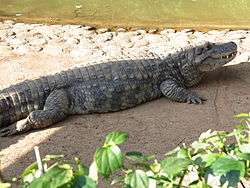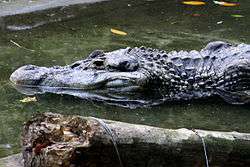Caiman
| Caimans Temporal range: Paleocene—Present, 60–0 Ma | |
|---|---|
 | |
| Yacare Caiman, Caiman yacare | |
| Scientific classification | |
| Kingdom: | Animalia |
| Phylum: | Chordata |
| Class: | Reptilia |
| Superorder: | Crocodylomorpha |
| Order: | Crocodilia |
| Family: | Alligatoridae |
| Subfamily: | Caimaninae Brochu, 1999 |
| Type species | |
| Caiman latirostris Daudincrrefwad, 1825 | |
| Genera and Species | |
|
See below | |
A caimán is an alligatorid crocodilian belonging to the subfamily Caimaninae, one of two primary lineages within Alligatoridae, the other being alligators.
Description
Caimans inhabit Central and South America. They are relatively mid-small sized crocodilians, with the smallest being Cuvier's dwarf caiman (Paleosuchus palpebrosus), which grows to 1 m (3 ft) long, and the largest being the black caiman (Melanosuchus niger), which can grow to 5 m (15 ft) or more. Caimans are distinguished from alligators, their closest (and more widely-known) relatives, by a few defining features: a lack of a bony septum between the nostrils, ventral armor composed of overlapping bony scutes formed from two parts united by a suture, and relatively longer, more slender teeth than those that alligators possess. Several extinct forms are known, including Purussaurus, a giant Miocene genus that grew to 12 m (39 ft) and the equally large Mourasuchus, which had a wide duck-like snout.[1]
Taxonomy





- Subfamily Caimaninae
- Genus †Centenariosuchus
- Genus †Culebrasuchus
- Genus †Eocaiman
- Genus †Globidentosuchus
- Genus Paleosuchus
- P. palpebrosus, Cuvier's dwarf caiman
- P. trigonatus, smooth-fronted caiman
- Genus †Purussaurus
- Genus †Mourasuchus
- Genus †Necrosuchus
- Genus †Orthogenysuchus
- Genus †Tsoabichi
- Clade Jacarea
- Genus Caiman
- C. yacare, Yacare caiman
- C. crocodilus, spectacled caiman
- C. c. apaporiensis, Rio Apaporis caiman
- C. c. fuscus, brown caiman
- †C. lutescens
- †C. venezuelensis
- C. latirostris, broad-snouted caiman
- Genus Melanosuchus
- †M. fisheri
- M. niger, black caiman
- Genus Caiman
Phylogeny
Below is a cladogram modified from Brochu (2011).[2]
| Alligatoridae |
| |||||||||||||||||||||||||||||||||||||||||||||||||||||||||||||||||||||||||||
| |
Below is a cladogram modified from Hastings et al. (2013).[3]
| |
| ||||||||||||||||||||||||||||||||||||||||||||||||||||||||||||||||||||||||||||||||||||||||||||||||||||||
| |
References
- ↑ Brochu, C. A. (1999). "Phylogenetics, Taxonomy, and Historical Biogeography of Alligatoroidea". Society of Vertebrate Paleontology Memoir 6: 9–100. doi:10.2307/3889340. JSTOR 3889340.
- ↑ Brochu, C. A. (2011). "Phylogenetic relationships of Necrosuchus ionensis Simpson, 1937 and the early history of caimanines". Zoological Journal of the Linnean Society 163: S228–S256. doi:10.1111/j.1096-3642.2011.00716.x.
- ↑ Hastings, A. K.; Bloch, J. I.; Jaramillo, C. A.; Rincon, A. F.; MacFadden, B. J. (2013). "Systematics and biogeography of crocodylians from the Miocene of Panama". Journal of Vertebrate Paleontology 33 (2): 239. doi:10.1080/02724634.2012.713814.
| ||||||||||